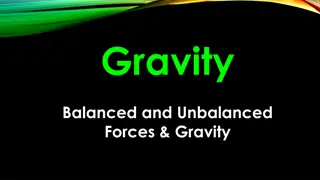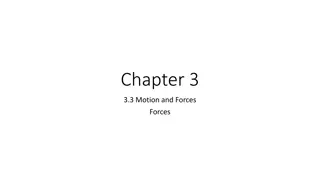Understanding Forces and Motion in Physics
Exploring the concepts of forces and motion, this content delves into the fundamental aspects of how forces impact objects' movement. Covering topics such as measuring force, representing force as a vector, combining forces through addition and subtraction, and understanding balanced and unbalanced forces. The significance of friction in opposing motion is also discussed.
Download Presentation

Please find below an Image/Link to download the presentation.
The content on the website is provided AS IS for your information and personal use only. It may not be sold, licensed, or shared on other websites without obtaining consent from the author. Download presentation by click this link. If you encounter any issues during the download, it is possible that the publisher has removed the file from their server.
E N D
Presentation Transcript
Chapter 12: Forces and Motion
Warm-Up Sept. 10 1.What is a force? 2.What direction is the force of gravity in? 3.What are the units of force?
Section 12.1 - Forces A force is a push or pull that acts on an object. A force can cause a resting object to move, or can accelerate a moving object by changing the object s speed or direction.
Measuring Force The stretch of the spring in a scale depends on the amount of weight (a type of force) acting on it. Force is measured in newtons (N). One newton is the force that causes a 1kg mass to accelerate a rate of 1m/s2. 1N = 1kg.m/s2
Representing Force You can use an arrow to represent force. The length represents the magnitude and the arrow head represents the direction. Force is a vector.
Combining Forces Forces combine by vector addition. Forces pointing in the same direction add together, and forces pointing in opposite directions subtract from one another. The net force is the overall force action on an object after all the forces are combined.
Balanced Forces Sometimes the net force acting on an object is zero. When the forces on an object are balanced, the net force is zero and there is no change in the object s motion.
Unbalanced Forces An unbalanced force is a force that results when the net force acting on an object is not equal to zero. When an unbalanced force acts on an object, the object accelerates. The net force equals the size of the larger force minus the size of the smaller force.
Friction All moving objects are subject to friction, a force that opposes the motion of objects that touch as they move past each other. There are four main types of friction: static friction, sliding friction, rolling friction, and fluid friction.
Static Friction Static friction is the friction force that acts on objects that are not moving. Static friction always acts in the direction opposite to that of the applied force.
Sliding Friction Sliding friction is a force that opposes the direction of motion of an object as it slides over a surface.
Rolling Friction When a round object rolls across a floor, the object and the floor are bent slightly. The change in shape when something rolls is the cause of rolling friction, the friction force that acts on rolling objects.
Fluid Friction Fluids are substances that flow like liquids and gases. The force of fluid friction opposes the motion of an object through a fluid. Fluid friction acting on an object moving through air is known as air resistance.
Gravity Gravity is an attractive force that acts between any two masses. Gravity does not require objects to be in contact for it to act on them.
Falling Objects As objects fall to the ground, they accelerate and gain speed. Gravity causes objects to accelerate downward, whereas air resistance acts in the direction opposite to the motion and reduces acceleration.
Falling Objects As the speed of a falling object increases, so does the air resistance. Terminal velocity is the constant velocity of a falling object when the force of air resistance equals the force of gravity.
Projectile Motion Projectile motion is the curved path of a falling object after it is given an initial forward velocity. The combination of an initial forward velocity and the downward vertical force of gravity causes the ball to follow a curved path.
Projectile Motion An object that is dropped and an object that is projected will strike the ground at the same time.
Section 12.1 Assessment 1. How is the motion of an object affected when a force acts on it? 2. List the four types of friction. 3. How does air resistance affect the acceleration of a falling object? 4. Earth s gravitational force acts in what direction?
Section 12.1 Assessment 5. Compare the strengths of static, sliding, and rolling friction. 6. Explain why falling leaves often do not fall in a straight-line path to the ground. 7. Two coins are knocked off a table at the same time by different forces. Which coin will hit the floor first?
Warm-Up Sept. 10 1.What is a newton? 2.What 2 forces act on a falling object? 3.What are the 4 types of friction?
Section 12.2 Newtons First and Second Laws of Motion Aristotle incorrectly proposed that force is required to keep an object moving at constant speed.
Galileo Galileo concluded that moving objects not subjected to friction or any other force would continue to move indefinitely.
Newtons First Law of Motion According to Newton s first law of motion, the state of motion of an object does not change as long as the net force acing on the object is zero.
Inertia Inertia is the tendency of an object to resist change in its motion. An object at rest tends to remain at rest, and an object in motion tends to remain in motion with the same speed and direction.
Newtons Second Law of Motion According to Newton s second law of motion, the acceleration of an object is equal to the net force acting on it divided by the object s mass. Mass is the amount of matter an object contains.
Newtons Second Law of Motion a = F/m acceleration = force/mass acceleration (a) = m/s2 force (F) = N mass (m) = kg
Sample Problems A car with a mass of 1000kg accelerates when the traffic light turns green. If the net force on the car is 4000N, what is the car s acceleration? m = 1000kg F = 4000N a = ? a = F/m a = 4000N = 4 m/s2 1000kg
Sample Problems A boy pushes a cart of groceries with a mass of 40kg. What is the acceleration of the cart if the net force is 60N? m = 40kg a = F/m F = 60N a = 60N = 1.50m/s2 a = ? 40kg An automobile with a mass of 1200kg accelerates at a rate of 3m/s2. What is the net force acting on the car? m = 1200kg a = F/m a = 3m/s2 F = ? F = 3m/s2 x 1200kg = 3600N F = a x m
Weight and Mass Mass is the amount of matter an object contains. Weight is the force of gravity acting on an object.
Weight W = m x g Weight = mass x gravity Weight (W) = N mass (m) = kg gravity (g) = 9.8 m/s2
Weight and Mass Mass is a measure of the inertia of an object, weight is a measure of the force of gravity acting on an object. On the moon, the acceleration due to gravity is about 1/6 that of the Earth.
Section 12.2 Assessment 1. State Newton s first law of motion in your own words. 2. What equation states Newton s second law of motion? 3. How is mass different from weight? 4. Describe an example of Newton s first and second laws that you observe in a normal day.
Section 12.2 Assessment 5. A dummy s mass is 75kg. If the net force on the dummy is 825N toward the rear of the car, what is the dummy s deceleration? m = 75kg F = 825N a = ? a = F/m a = 825N = 11m/s2 75kg
Warm-Up Sept. 11 1.What is the difference in mass and weight? 2.What is g and what is its value? 3.What is the mass of an object that is accelerating 4.1 m/s2 by a 36N force?
Section 12.3 Newtons Third Law of Motion and Momentum A force cannot exist alone. Forces always exist in pairs. According to Newton s third law of motion, for every force there is an equal and opposite force.
Action and Reaction Force The force object A exerts on object B is called the action force. The force that object B exerts back on object A is called the reaction force.
Action and Reaction Forces Action-reaction forces can produce motion like when a swimmer takes a stroke. Action-reaction forces sometimes produce no motion like when you push against a wall.
Action and Reaction Forces Action and reaction forces do not cancel because although they are in different directions, they are also acting on different objects.
Momentum Momentum is the product of an object s mass and its velocity. An object with a large momentum is hard to stop. The momentum for any object at rest is zero.
Momentum p = m x v momentum = mass x velocity momentum (p) = kg.m/s mass (m) = kg velocity (v) = m/s
Conservation of Momentum According to the law of conservation of momentum, if no net force acts on a system, then the total momentum of the system does not change.
Law of Conservation of Momentum In a closed system, the loss of momentum of one object equals the gain in momentum of another object.
Section 12.3 Assessment 1. Using Newton s third law, explain what is meant by action and reaction forces. 2. State in your own words the formula for momentum. 3. What is a necessary condition for the conservation of momentum? 4. Explain how Newton s third law of motion is at work when you walk.
Section 12.3 Assessment 5. If an eagle and a bumblebee are traveling at 8km/hr, which has more momentum? Explain.
Warm-Up Sept. 17 1. What is the symbol for momentum? 2. What is an example of a pair of action- reaction forces? 3. What is the mass of an object that has a momentum of 30 kg.m/s and a velocity of 20m/s?
Section 12.4 Universal Forces The four universal forces are the electromagnetic, strong nuclear, weak nuclear, and gravitational forces. All the universal forces act over a distance between particles of matter, which means that the particles do not need to be in contact with one another.
Electromagnetic Forces Electromagnetic force is associated with charged particles. Electric force and magnetic force are the only force that can both attract and repel.























